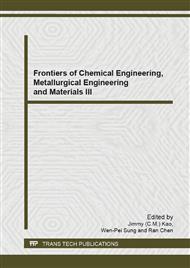p.592
p.599
p.605
p.610
p.614
p.618
p.624
p.628
p.633
Study of Synthesis of SiO2 Aerogel from Coal Gangue at an Ambient Pressure
Abstract:
The hydrophobic SiO2 aerogel was prepared by using coal gangue as the starting material—which is viewed as waste in most coal mining and preparation plant—via ambient pressure drying through sol-gel method. The effects of different temperature, time to keep the temperature,vary in mass ratio of coal gangue to sodium hydroxide on the leaching ratio of SiO2 from coal refuses are discussed in this paper. Results showed that the leaching ratio of SiO2 extracted from gangue will be made up to 35.23% compared with the other tests on the condition that the temperature is given 750°C, holding time 2h, the value of ratio of coal gangue to sodium hydroxide 1:0.8, concentration of NaOH 20%. Trimethylchlorosilane (TMCS) is used as modifier to obtain hydrophobicity through solvent exchange and surface modification. We achieved SiO2 aerogel with low density of 0.2559g/cm3, high porosity 88.97%,Strong hydrophobicity (contact angle with water 140.61。) respectively, which demonstrated that the final product exhibits excellent property. Differences among SiO2 aerogel properties were discussed between industrial sodium silicate as precursor and sodium silicate drew from coal gangue as precursor. Results revealed that the the latter is better than the former on properties .Our work provided a potential way to synthetize high value-added product from abandoned by-product coal gangue.
Info:
Periodical:
Pages:
614-617
Citation:
Online since:
August 2014
Authors:
Price:
Сopyright:
© 2014 Trans Tech Publications Ltd. All Rights Reserved
Share:
Citation:


